Marketers have long understood the importance of the customer persona — a semi-fictional representation of ideal customers based on market research and data about existing clients.
But as more businesses rely on social media marketing to connect with audiences, marketers are discovering the essential role social media personas play in having a clear, distinguished digital voice.
In this article, we’ll explore what social media personas are, why they are important, and how you can leverage social media analytics to develop accurate and effective personas for your business.
Table of Contents
What is a social media persona?
Why are social media personas important for your business?
What every social media persona profile should include
How to infuse social media personas with brand elements
7 ways to define your social media persona
Types of social media personas
How many social media personas do you need?
Keep your social media personas fresh
What is a social media persona?
A social media persona, sometimes also referred to as a social media avatar, is a representation of your ideal customer based on real-world data and insights gathered from analyzing people's activity on social media platforms.
Developing social media personas helps brands create more targeted social marketing strategies, improve customer engagement and experience, and boost social media ROI.
Do you need a social media persona if you already have a customer persona?
Yes, because they serve distinct purposes and are created based on different data sets.
A social media persona highlights the behaviors, interests, and interactions of people on social platforms. This persona helps brands create content and campaigns that resonate well with people in specific social media environments.
In contrast, a marketing persona is a comprehensive representation of a target customer based on demographics, purchasing behavior, goals, and pain points. A buyer persona captures not only online behaviors but also motivations and challenges throughout the wider customer journey.
Both personas will have common elements, but they serve different — albeit complementary — business purposes and stages of the buying cycle.
Why are social media personas important for your business?
Short answer: because you want to have a successful online presence and leverage it to sell products and services.
Not to exaggerate, but getting to know your social media audience means everything in 2024, as Adina Jipa, Founder and CMO at Socialinsider, explains on the Stories and Strategies podcast.
Let’s look into the benefits in more detail.
Develop social media empathy
Imagine trying to connect to a person without having any clue about who they are (or trying to find out). Almost impossible.
The same goes for creating content. Without deeply understanding your audience, it’s very difficult to be relevant and compelling.
A social media persona enables your social media managers to see the world from customers' perspectives and put themselves in their shoes.
This empathy-driven approach helps create content that resonates with the audience’s needs, preferences, and pain points, making your communication more effective and authentic.
Have a competitive advantage
Buyer personas for social media allow you to tailor your content and offering to meet your clients’ needs better than your competitors.
Insights included in a social media persona profile can give you a significant edge in the market, enabling you to deliver superior customer experiences and build stronger relationships.
Attract the right leads for your business
A common pitfall for businesses is generating a lot of leads (yay!) only to find later in the buyer's journey that they are unqualified (yikes!). This wastes a lot of marketing and sales resources in the long run and affects the bottom line.
Social media personas give businesses a clear picture of their audience, making top-of-funnel targeting more efficient and increasing the chances that the right people will connect with the business.
The result?
Higher social media click-through rates, more conversions, and happier stakeholders.
Manage social media crises effectively
Understanding your audience helps you anticipate and prepare for potential issues that could arise.
In a crisis, knowing how your customers are likely to react allows you to create timely and appropriate responses, maintaining trust and mitigating negative impacts.
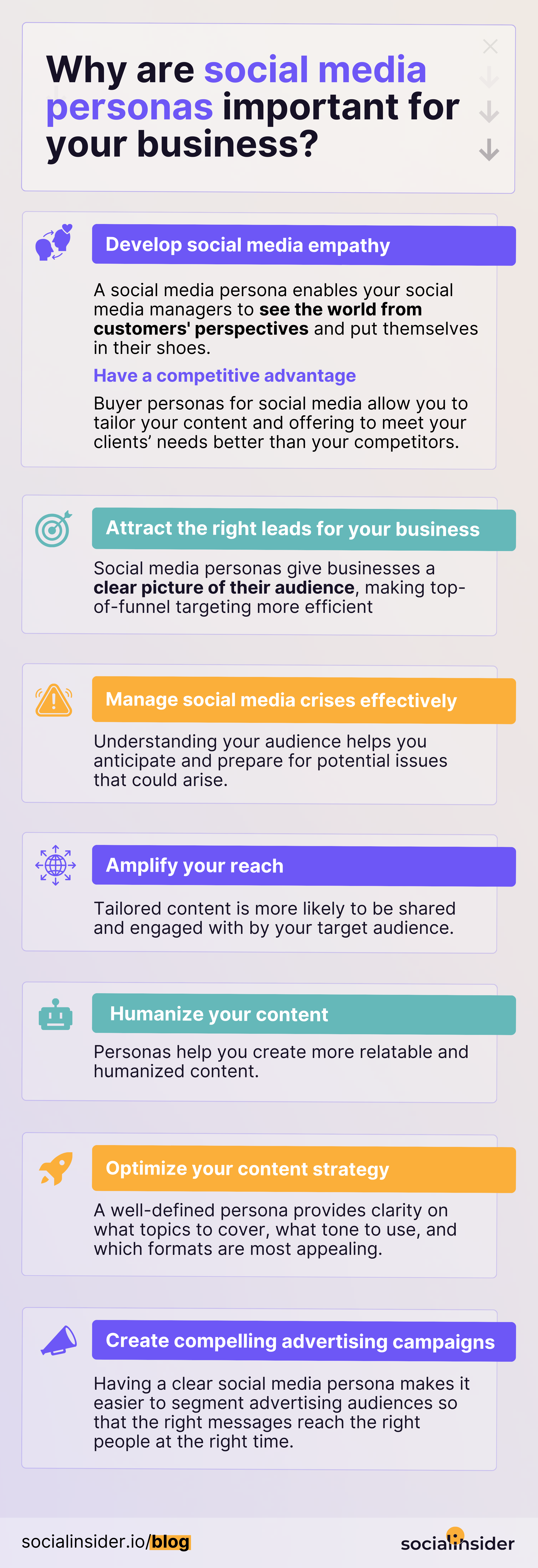
Amplify your reach
Tailored content is more likely to be shared and engaged with by your target audience.
When your audience finds your content relevant and valuable, they are more inclined to share it, thereby amplifying your reach and expanding your brand’s visibility organically.
Humanize your content
Personas help you create more relatable and humanized social media content.
By reflecting the language, values, and interests of your audience, you make your brand more approachable and trustworthy.
Content created with a unique social media persona in mind is more likely to create meaningful connections and foster loyalty.
Optimize your content strategy
A well-defined persona provides clarity on what topics to cover, what tone to use, and which formats are most appealing.
It's like a guiding light in a sea of possibilities that lets you be strategic and consistent in content creation.
Create compelling advertising campaigns
Having a clear social media persona makes it easier to segment advertising audiences so that the right messages reach the right people at the right time.
For example, persona consistent ads generate twice the results compared to ads with no specific audience targeting, according to Protocol80.
This optimization ensures that ad budgets are spent more efficiently and that resources are focused where it matters.
Overall, personas allow you to communicate more efficiently and make better use of the always-limited resources.
What every social media persona profile should include
Looking for a social media persona template to get started quickly? We got you covered.
Below, you'll find a short and sweet guide to everything a social persona should include to make it relevant and useful for your strategy and team.
1. Demographics
- Age — tailor content to different life stages
- Gender — understand specific content preferences
- Location — time zones, cultural nuances, and local trends
- Income level - determines the affordability of your products/services
- Education level - guides the complexity of your content and messaging
- Occupation — better targeting with industry, job title, and seniority information
2. Psychographic data: Values, goals, and pain points
- Values — principles or beliefs of your ideal customers
- Goals (personal and professional) - what they are striving to achieve
- Pain points — challenges, problems, and obstacles clients are facing that your business can solve
3. Interests
- Topics of interest - subjects that they are passionate about or engaged in
- Hobbies and activities - what people in your target audience do in their free time
4. Personality traits
- Dominant traits - understand the main personality types to adjust your tone of voice and messaging appropriately
5. Favorite brands on social media
- Brands they follow and engage with — which brands do they engage with most on social media?
6. Source of Information
- Preferred information channels - social media platforms, blogs, podcasts, news sites, etc.
- Influencers — who your clients like and follow
- Groups — social media groups and communities that your target audience is more likely to join and be active in
7. Social media habits
- Platforms used — social media platforms they use most frequently
- Engagement style — do they actively engage by commenting and sharing, or are they passive consumers of content?
- Content preferences — types of content do they prefer (videos, articles, infographics, memes, etc.)
- Time spent on social media — average time spent on social media by platform
- Peak activity times — when they most active on social media
8. Business-specific attributes
- Business size — for B2B social media personas, knowing the size of their company can help tailor your approach.
- Decision maker status — role in the purchasing decisions in the organizations, such as a decision maker, influencer, etc.
All this information helps you put together a puzzle that reveals who your social media persona is. The details will enable you to create content with confidence, knowing that you're talking with the right person and that you're maximizing engagement.
How to infuse social media personas with brand elements
It's great to know your ideal clients in detail and speak their language. But to get results for your business, you also must seamlessly integrate your business attributes into your social media personas.
Here's how to do that efficiently:
Tone of voice
First, ensure that your social media tone of voice is clearly defined. If it's not, spend some time with your team deciding whether your communication style should be professional, friendly, humorous, authoritative, or a mix tailored to different contexts.
Once the tone of voice is clear, adapt it to match the preferences and expectations of your target audience and the particularities of different channels.
For example, a professional tone might resonate well on LinkedIn, while a more casual and engaging tone could be suitable for Instagram.
Slight adaptations can help you communicate more effectively while maintaining the core brand voice.
Preferred social media platforms
Determine which social media platforms your target personas use the most and focus your efforts on there to maximize engagement and reach.
Develop strategies and content tailored to each platform's features and audience behavior.
For example, use LinkedIn for B2B interactions and professional content, Instagram for visual storytelling, and X (previously Twitter) for real-time updates and engagement.
Follow social media trends, as audiences tend to change their behavior and preferences. Refine your approach periodically to stay relevant.
Preferred content type
Identify the types of content your audience prefers, such as articles, infographics, videos, memes, or user-generated content. This ensures that your social media strategy aligns with their consumption habits.
Leverage various content formats, such as short-form videos for quick engagement on Instagram and TikTok, detailed articles for in-depth information on LinkedIn, and interactive polls on Twitter.
Analyze engagement metrics to understand what types of content resonate with your audience and catch any changes in user behavior and preferences.
By taking all these elements into account, you can create a strong social media persona that informs and improves your strategic decisions.
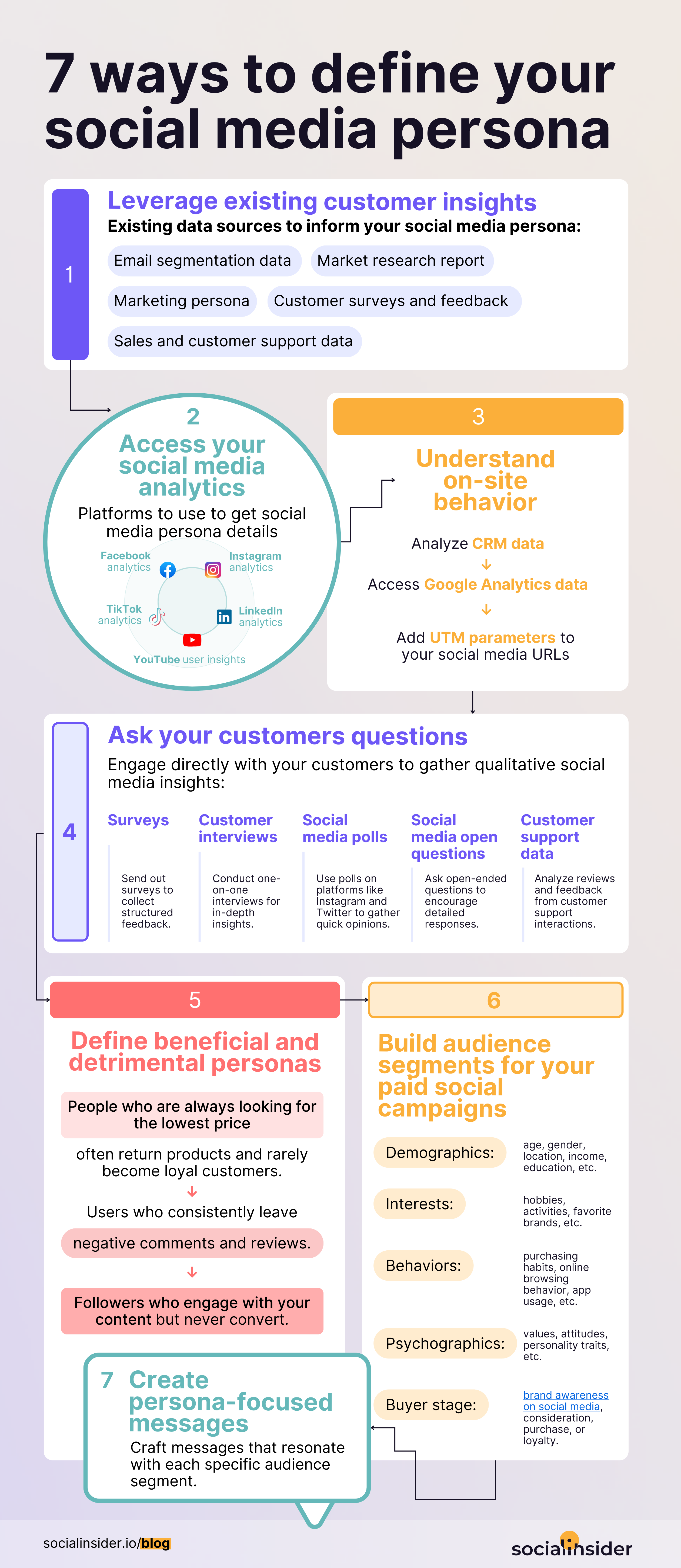
7 ways to define your social media persona
Your social media persona will only be as good as the data and information you use to build it. Accuracy, source credibility, and diversity are key.
Let’s look at some of the most reliable and rich sources and methods to use to craft compelling social media personas.
1. Leverage existing customer insights
No need to start from scratch if you already have a good understanding of your customers.
If your marketing team has developed buyer personas, you're off to a great start, as you can readily access demographics, interests, pain points, and goals. Adapt this information to a social media context and complete it with channel-specific data and insights.
Potential existing data sources to inform your social media persona:
- Marketing persona
- Email segmentation data
- Customer surveys and feedback
- Sales and customer support data
- Market research report
2. Access your social media analytics
What better way to get to know your social media audience than looking at who is following and engaging with your brand pages?
The analytics available on various social media platforms help you gain deeper insights into your audience and inform your persona.
Socialinsider provides detailed reports for various channels to help you quickly get valuable insights without the hassle of switching platforms and integrating data.
- Facebook analytics - Understand the demographics, interests, and behaviors of your Facebook audience.
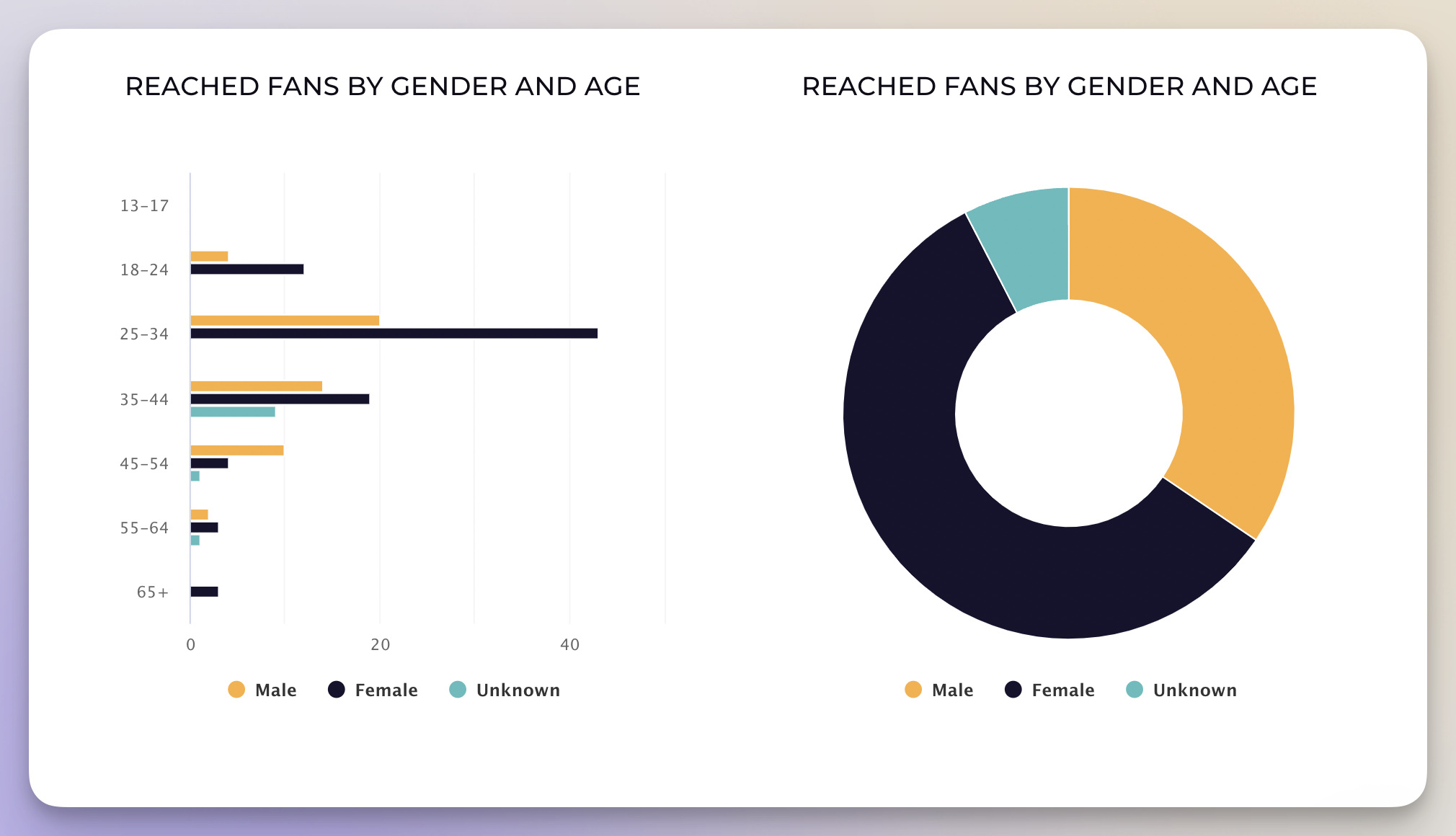
- Instagram analytics - Analyze follower demographics, engagement metrics, and content performance.
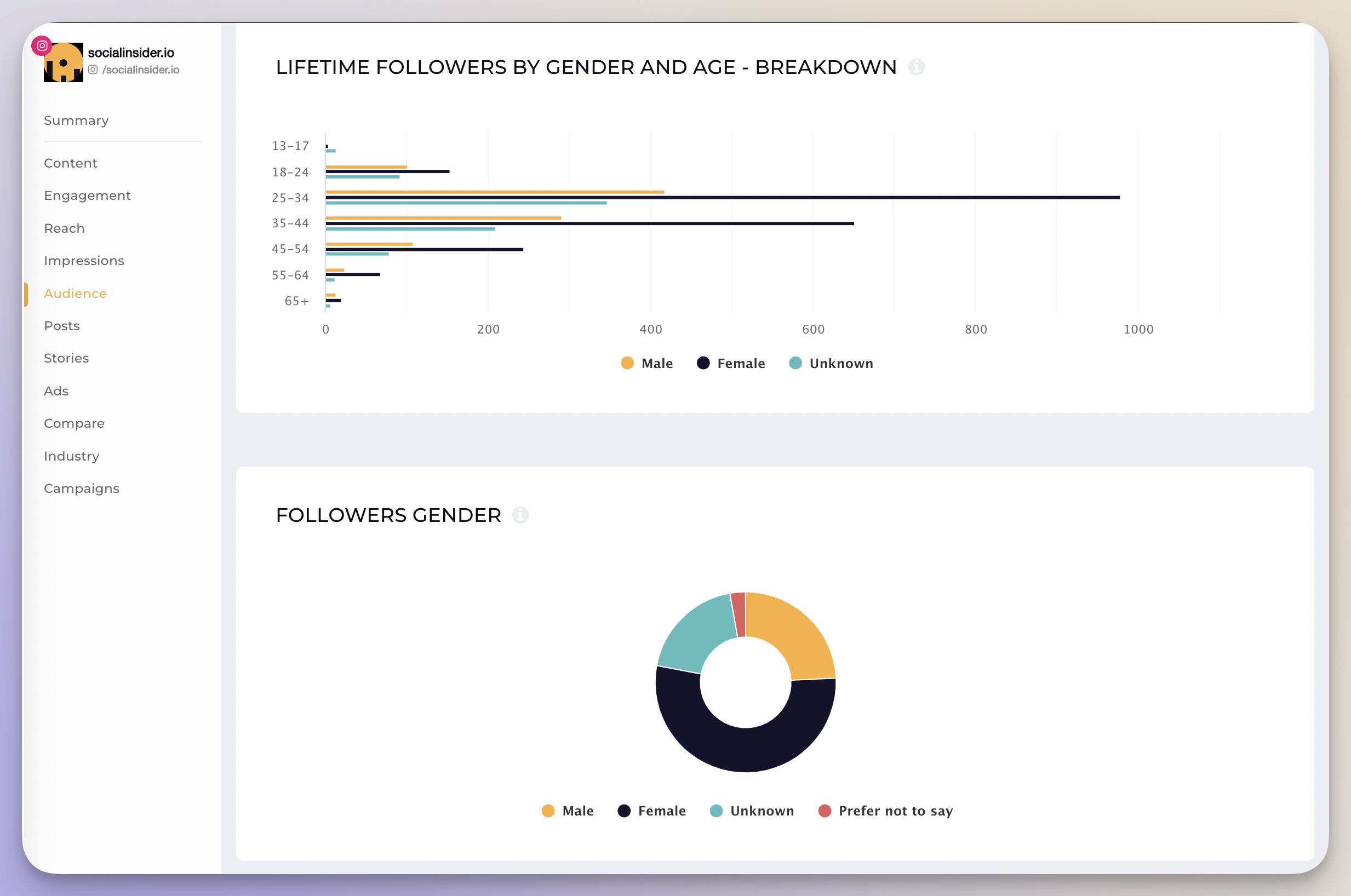
- LinkedIn analytics - Explore professional details like job titles, industries, and seniority.
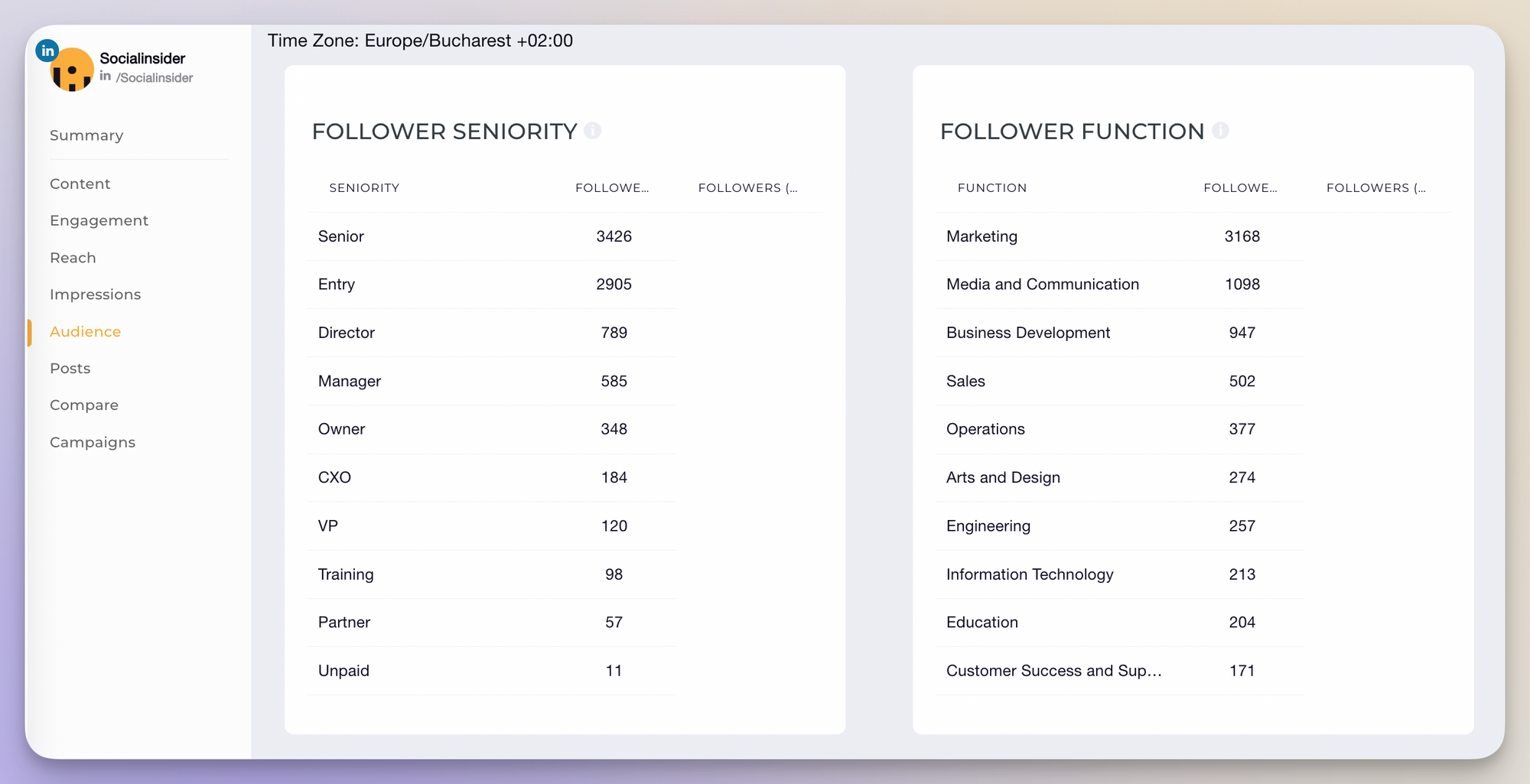
- TikTok analytics. View follower demographics, video performance, and trends.
- YouTube user insights. Check audience demographics, watch time, and viewer engagement.
3. Understand on-site behavior
Analytics from your website provide plenty of insights into how your audience interacts with your brand and also into what happens with traffic coming from social media.
- Analyze CRM data for detailed customer profiles based on sales and marketing data.
- Access Google Analytics data, such as social media traffic, browsing behaviors, and conversion rates. To better understand user behavior coming from specific social media posts, be sure to use UTM parameters.
- Add UTM parameters to your URLs to monitor which social media campaigns drive the most traffic and conversions.
4. Ask your customers questions
Sometimes, getting to know people is as easy as asking a few questions.
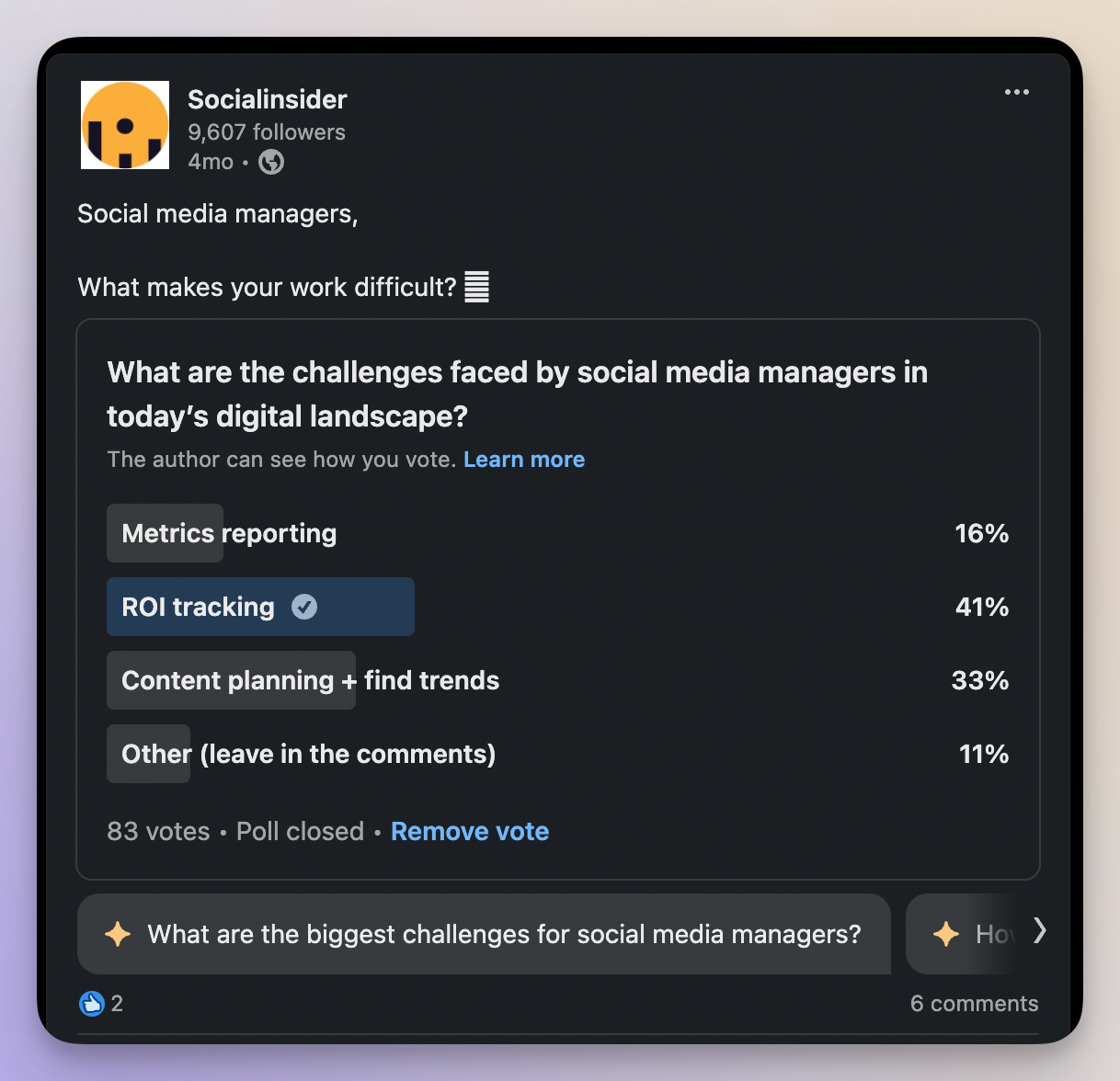
Engage directly with your customers to gather qualitative social media insights:
- Surveys — Send out surveys to collect structured feedback.
- Customer interviews — Conduct one-on-one interviews for in-depth insights.
- Social media polls — Use polls on platforms like Instagram and Twitter to gather quick opinions.
- Social media open questions — Ask open-ended questions to encourage detailed responses.
- Customer support data — Analyze reviews and feedback from customer support interactions.
5. Define beneficial and detrimental personas
Identify different segments within your audience based on their unique characteristics and behaviors and differentiate between types of segments.
For example, it's important to recognize and define negative social media personas — those that may have a detrimental impact on your brand.
Negative personas are typically segments of your audience that are unlikely to convert, may spread negative feedback, or engage in disruptive behavior.
Examples may include:
- People who are always looking for the lowest price often return products and rarely become loyal customers.
- Users who consistently leave negative comments and reviews.
- Followers who engage with your content but never convert.
Careful segmentation enables you to more easily identify undesirable customer behaviors and refine your targeting and focus.
6. Build audience segments for your paid social campaigns
Now that you know how to refine your social media persona to only address the right people, it's time to get granular.
After all, 62% of marketers say that personalization is their most effective technique and 80% of companies that use market segmentation report increased sales, according to NotifyVisitors.
Especially when it comes to paid social media campaigns, creating well-defined audience segments is crucial. By targeting specific groups of people, you can deliver more relevant messages, increase engagement, and improve your ROI.
Here are some key factors to consider when building your audience segments:
- Demographics: age, gender, location, income, education, etc.
- Interests: hobbies, activities, favorite brands, etc.
- Behaviors: purchasing habits, online browsing behavior, app usage, etc.
- Psychographics: values, attitudes, personality traits, etc.
- Buyer stage: brand awareness on social media, consideration, purchase, or loyalty.
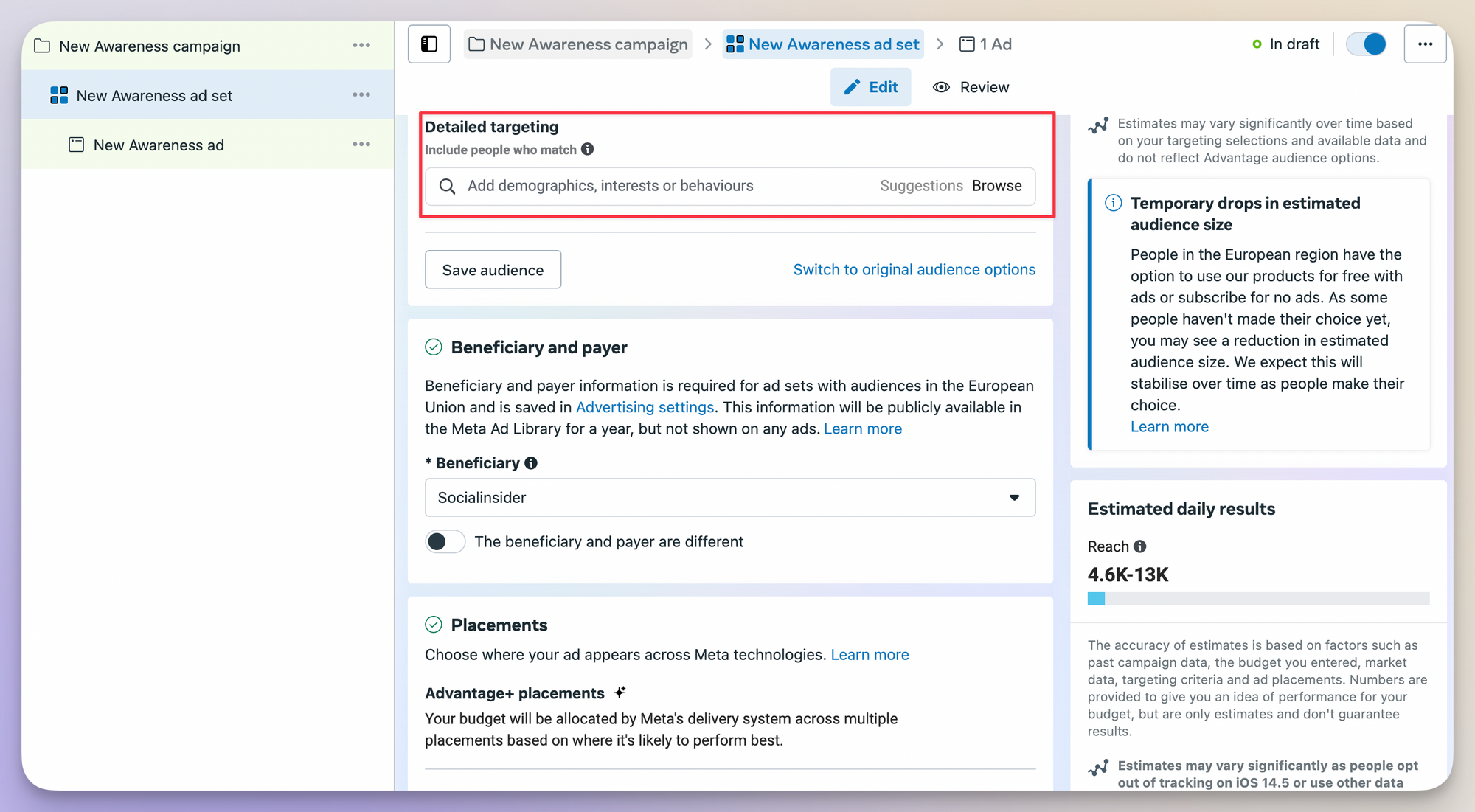
Below are a few common social media audience segment types to help you get started:
- The core audience, based on your ideal customer profile.
- Lookalike audiences, formed by people similar to your existing customers who are also likely to engage with your brand.
- Engagement audiences, created from people who have interacted with your brand on social media or on other communication channels.
- Existing customers, segmented by type or value of purchase.
- Inactive customers who haven't purchased in a while but could be reactivated.
7. Create persona-focused messages
Once you've developed detailed social media personas, the next step is to craft messages that resonate with each specific audience segment. This involves tailoring your content to address their unique needs, desires, and pain points.
A few social media best practices to communicate effectively:
- Understand and use your persona's unique language, including jargon and tone of voice.
- Always focus on benefits, not just on features. Explain how your product or service solves people's specific problems.
- End strong with a compelling call to action that encourages the desired behavior, such as buying, signing up for a newsletter, or sharing content.
- Experiment with different messages to see what works best for various personas and segments.
- Use the right images and videos to enhance your message. Remember that while some audiences may like beautiful, polished visuals, others may enjoy more raw and authentic graphics.
Types of social media personas
While social media managers — creative as they are — come up with different names and labels for their personas, here are some common types that any business will need:
- Primary persona. This is your ideal customer, the person most likely to buy your product or service. You can have more than one primary persona.
- Secondary persona. This persona is similar to the primary persona but has slightly different needs or preferences and is not the main focus of your social media efforts. Again, you can have mutiple personas.
- Influencer persona. This persona is someone who can influence your target audience's purchasing decisions and who you need to have on your side. Depending on your audience, there may be multiple influencers in the buying decision. Choose the most important one(s).
- Platform-specific persona. This persona is tailored to a particular social media platform, taking into account specific behaviors and preferences that determine content types, themes, and targeting. Create a social media persona segment for each platform that you use.
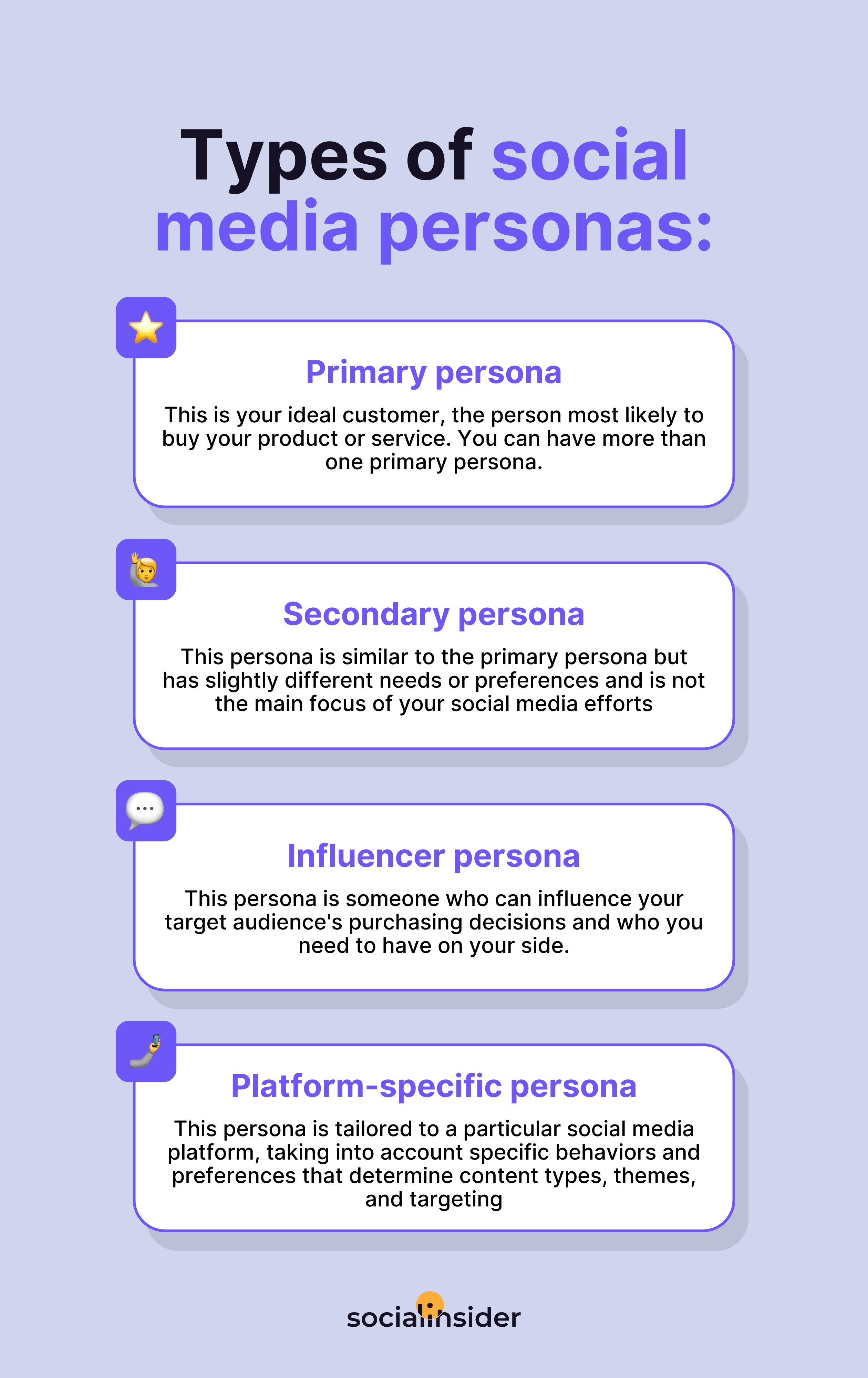
Beyond these generic types, you can think of social media persona types based on different criteria, such as demographics and interests:
- The tech-savvy student. Early adopter, interested in trends and new tech.
- The busy professional. Uses social media for networking and staying informed.
- The stay-at-home parent. Connects with other parents, usually in social media groups, shares parenting tips, and looks for deals.
- The senior citizen. Primarily uses social media for staying in touch with family and friends.
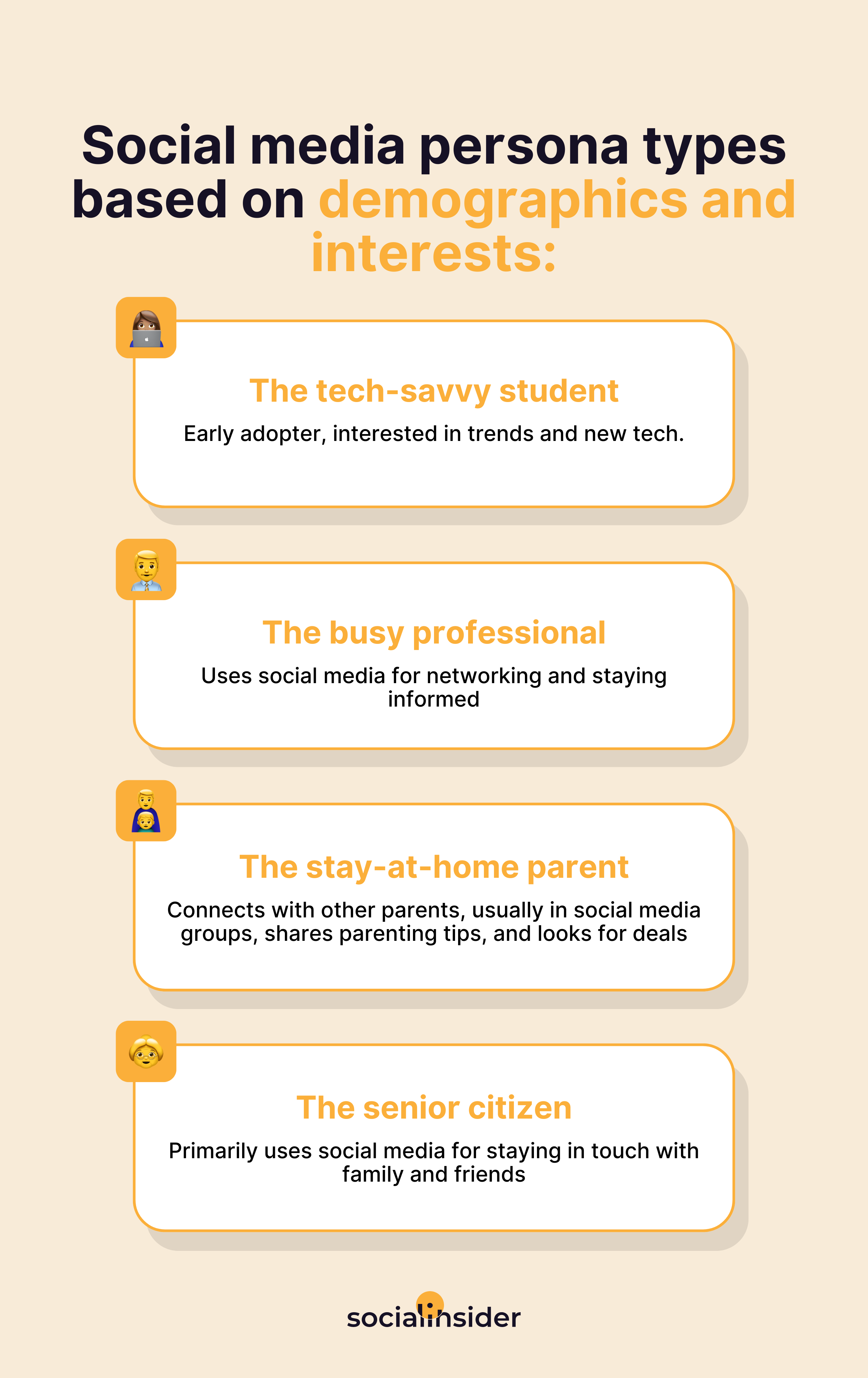
Based on personality traits and behavior, you can segment social media audiences as follows:
- The influencer. Aspires to build a large following and impact others.
- The observer. Prefers to consume content without engaging actively.
- The commentator. Shares thoughts and perspectives frequently.
- The entertainer/innovator. Uses humor and creativity to engage with others.
- The empath. Connects with others on a deeper level, offering support and understanding.
- The thought leader. Shares valuable information and insights from experience.
These are just a few examples to get your mind going. You can (and should) create more specific personas based on your target audience's unique characteristics.
But how far should you go with persona creation?
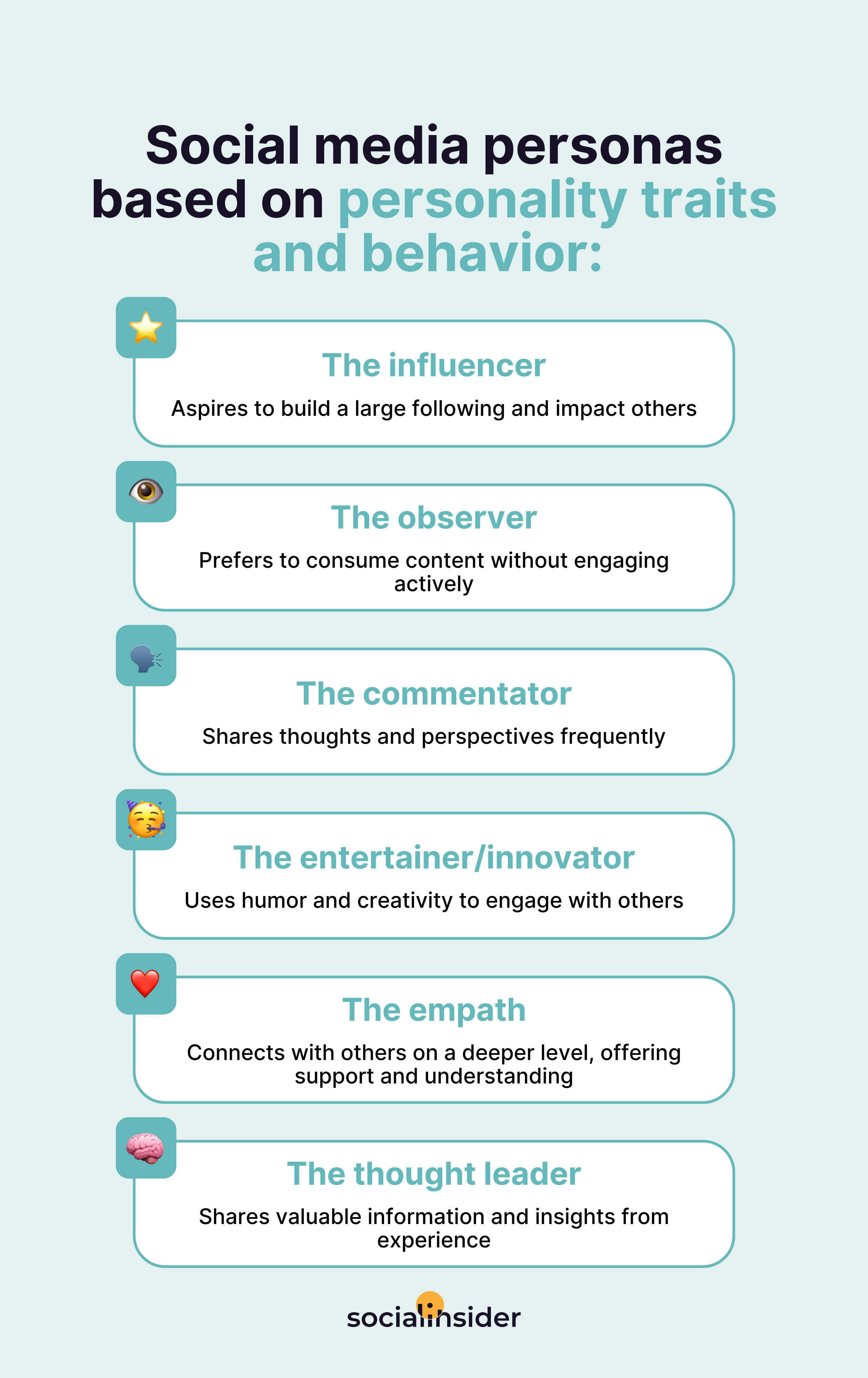
How many social media personas do you need?
The number of social personas you need will depend on the diversity of your audience and the specificity of your social media goals.
While there's no rule on the number of personas you should create, most businesses find that between three and seven personas provide a good balance of detail and manageability.
Less than three may mean your social media personas are too general and won't help you refine your targeting efficiently. More than seven can either result in too much granularity and repetition or include personas that are not as relevant to the brand.
When you're just starting out with creating social media personas, keep these best practices in mind:
- Begin with 3-4 well-defined personas. This allows you to focus on the most significant segments of your audience without becoming overwhelmed.
- Ensure each persona is detailed and actionable, providing clear insights into how you can effectively engage and convert each segment.
- As you gather more data and insights, refine and possibly expand your personas to include additional segments.
- Involve your entire marketing team in the process, as well as other stakeholders who can provide valuable insights into customer profiles.
Keep your social media personas fresh
Algorithms change more often than a social media strategist can keep track. And so do audiences, but, luckily, with the right tools, you can stay competitive and relevant.
Social media personas should be living, breathing representations of your target audience. Your customers are influenced by trends, technological advancements, and changes in their own lives.
Here's why you should refine social media personas regularly:
- Consumer evolution. Consumer preferences, habits, and values shift. What resonated with your audience a year ago might not be as effective today.
- Technological advancements. New platforms, features, and algorithms influence how people consume content and interact with brands.
- Market conditions. Economic conditions, industry trends, and competitor actions can impact your target audience and their needs.
- Access to data. Regular analysis of social media analytics, website traffic, and customer feedback provides valuable data that may require persona refinement.
- Brand evolution. As your brand matures, your target audience may evolve as well. Do a regular brand audit and align personas to updates.
Include these steps in your marketing routine to keep social media personas fresh and relevant:
- Conduct periodic reviews of your social media personas to assess their accuracy and relevance.
- Use social media analytics tools to track audience behavior, demographics, and interests and notice changes in trends.
- Analyze your competition's social media activity regularly to identify successful strategies as well as areas of improvement.
- Measure social sentiment to determine whether you’re communicating effectively with your audience and proactively addressing and correcting issues.
- Gather insights from customer surveys, social media comments, and other interactions.
Congratulations! You are now equipped to create and update the ideal customer persona for your social media messages.
Final Thoughts
Accurate social media personas are a must for brands that want to glow on Instagram, go viral on TikTok, and attract leads and talent on LinkedIn.
No matter the mix of platforms you use, generic customer personas are not enough anymore to ensure successful social media strategies.
By leveraging the power of data and insights, you can craft social personas that help you communicate in a genuine, relevant, and effective way with different audience segments. Try Socialinsider today to start building data-d







